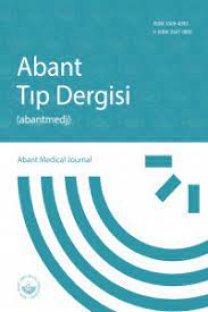Koroner yavaş akım olan hastalarda pentraksin-3 düzeyi artmıştır
Koroner yavaş akım, hs-CRP, inflamasyon, Pentraksin-3
Increased pentraxin-3 level in patients with slow coronary flow
Slow coronary flow, Pentraxin-3, hs-CRP,
___
- Tambe AA, Demany MA, Zimmerman HA, Mascarenhas E. Angina pectoris and slow flow velocity of dye in coronary arteries--a new angiographic finding. Am Heart J 1972; 84: 66-71.
- Gibson CM, Cannon CP, Daley WL, Dodge JT, Jr., Alexander B, Jr., Marble SJ, McCabe CH, Raymond L, Fortin T, Poole WK, Braunwald E. TIMI frame count: a quantitative method of assessing coronary artery flow. Circulation 1996; 93: 879-88.
- Goel PK, Gupta SK, Agarwal A, Kapoor A. Slow coronary flow: a distinct angiographic subgroup in syndrome X. Angiology 2001; 52: 507-14.
- Kaski JC, Tousoulis D, Galassi AR, McFadden E, Pereira WI, Crea F, Maseri A. Epicardial coronary artery tone and reactivity in patients with normal coronary arteriograms and reduced coronary flow reserve (syndrome X). J Am Coll Cardiol 1991; 18: 50-54.
- Pekdemir H, Cin VG, Cicek D, Camsari A, Akkus N, Doven O, Parmaksiz HT. Slow coronary flow may be a sign of diffuse atherosclerosis. Contribution of FFR and IVUS. Acta Cardiol 2004; 59: 127-33.
- Ari H, Ari S, Erdogan E, Tiryakioglu O, Huysal K, Koca V, Bozat T. The effects of endothelial dysfunction and inflammation on slow coronary flow. Turk Kardiyol Dern Ars 2010; 38: 327-33.
- Hansson GK. Inflammation, atherosclerosis, and coronary artery disease. N Engl J Med 2005; 352: 1685-95.
- Li JJ, Qin XW, Li ZC, Zeng HS, Gao Z, Xu B, Zhang CY, Li J. Increased plasma C-reactive protein and interleukin-6 concentrations in patients with slow coronary flow. Clin Chim Acta 2007; 385: 43-47.
- Libby P, Ridker PM, Hansson GK. Inflammation in atherosclerosis: from pathophysiology to practice. J Am Coll Cardiol 2009; 54: 2129-38.
- Karakas MF, Buyukkaya E, Kurt M, Motor S, Akcay AB, Karakas E, Buyukkaya S, Sen N. Serum Pentraxin-3 Levels Are Associated with the Severity of Metabolic Syndrome. Med Princ Pract 2012: (inpress)
- Salio M, Chimenti S, De Angelis N, Molla F, Maina V, Nebuloni M, Pasqualini F, Latini R, Garlanda C, Mantovani A. Cardioprotective function of the long pentraxin PTX3 in acute myocardial infarction. Circulation 2008; 117: 1055-64.
- Karakas MF, Buyukkaya E, Kurt M, Motor S, Akcay AB, Buyukkaya S, Karakas E, Bilen P, Sen N. Serum Pentraxin 3 Levels Are Associated With the Complexity and Severity of Coronary Artery Disease in Patients With Stable Angina Pectoris. J Investig Med 2012: (inpress)
- Vane JR, Anggard EE, Botting RM. Regulatory functions of the vascular endothelium. N Engl J Med 1990; 323: 27-36.
- Li JJ. Inflammation in coronary artery diseases. Chin Med J (Engl) 2011; 124: 3568-75.
- Li JJ, Xu B, Li ZC, Qian J, Wei BQ. Is slow coronary flow associated with inflammation? Med Hypotheses 2006; 66: 504-08.
- Madak N, Nazli Y, Mergen H, Aysel S, Kandaz M, Yanik E, Cekdemir D, Tavli T. Acute phase reactants in patients with coronary slow flow phenomenon. Anadolu kardiyoloji dergisi : AKD = the Anatolian journal of cardiology 2010; 10: 416-20.
- Sen N, Ozlu MF, Basar N, Ozcan F, Gungor O, Turak O, Malcok O, Cagli K, Maden O, Erbay AR, Demir AD. Relationship between elevated serum gamma- glutamyltransferase activity and slow coronary flow. Turk Kardiyol Dern Ars 2009; 37: 168-73.
- Bottazzi B, Doni A, Garlanda C, Mantovani A. An integrated view of humoral innate immunity: pentraxins as a paradigm. Annu Rev Immunol 2010; 28: 157-83.
- Mantovani A, Garlanda C, Bottazzi B, Peri G, Doni A, Martinez de la Torre Y, Latini R. The long pentraxin PTX3 in vascular pathology. Vascul Pharmacol 2006; 45: 326-30.
- Maugeri N, Rovere-Querini P, Slavich M, Coppi G, Doni A, Bottazzi B, Garlanda C, Cianflone D, Maseri A, Mantovani A, Manfredi AA. Early and transient release of leukocyte pentraxin 3 during acute myocardial infarction. J Immunol 2011; 187: 970-79.
- Sen N, Basar N, Maden O, Ozcan F, Ozlu MF, Gungor O, Cagli K, Erbay AR, Balbay Y. Increased mean platelet volume in patients with slow coronary flow. Platelets 2009; 20: 23-28.
- Yayın Aralığı: 6
- Başlangıç: 2012
- Yayıncı: Bolu Abant İzzet Baysal Üniversitesi Tıp Fakültesi Dekanlığı
Çocuklarda humerus lateral kondil kırığı tedavi sonuçları
Cengiz IŞIK, Abdullah Alper ŞAHİN, Hüsamettin ÇAKICI, Yasin DURUKAN, Fuat AKPINAR
Koroner yavaş akım olan hastalarda pentraksin-3 düzeyi artmıştır
Eyüp BÜYÜKKAYA, Mehmet Fatih KARAKAŞ, Mustafa KURT, Esra KARAKAŞ, Şule BÜYÜKKAYA, Adnan Burak AKÇAY, Nihat ŞEN
Katarakt cerrahisinde sedasyonun yeri
Halil İbrahim ÖNDER, Ümit Yaşar TEKELİOĞLU, Abdullah DEMİRHAN, Mesut ERDURMUŞ
Skrotal Kaposi sarkomu: Bir Olgu Sunumu
Hakan TURAN, Esma USLU, Feyza BAŞAR, Havva ERDEM
Kansere Bağlı Ağrı ve Tedavisi
Deniz ARSLAN, Ali Murat TATLI, Ümmügül ÜYETÜRK
Larenks kanserinin nadir metastaz yeri: böbrek metastazı saptanan bir olgu sunumu
Selçuk Yusuf ŞENER, İlhan DOLAŞIK, Gokhan ERBAG, İbrahim Hakkı DURSUN, Selvet ERDOĞAN
Renal Kolik İle Giden İlginç Bir Aktinomikoz Olgusu
Lora ATEŞ, Basri ÇAKIROĞLU, Ramazan GÖZÜKÜÇÜK, Süleyman Hilmi AKSOY, Mustafa GÜÇLÜ
Alim ERDEM, Fatih CANAN, Sabri Onur ÇAĞLAR, Osman YILDIRIM
Hipertrigliseridemi sonucu oluşan nekrotizan pankreatit olgusunda diyabet gelişimi
Hacer ŞEN, Emine BİNNETOĞLU, Fahri GÜNEŞ, Mehmet AŞIK, Betül KIZILDAĞ, Şengül ÖZÇELİK, Kubilay UKİNC
Asemptomatik Vajinal Akıntı İle Belirlenen Uterin Karsinosarkom; Nadir Bir Olgu
